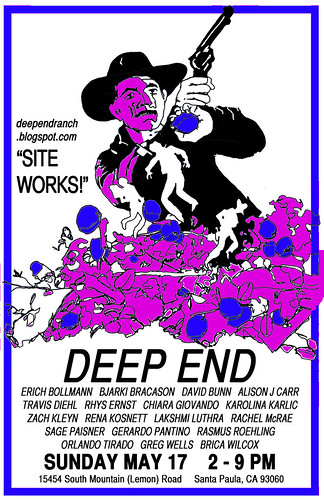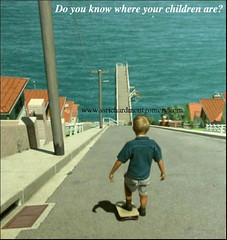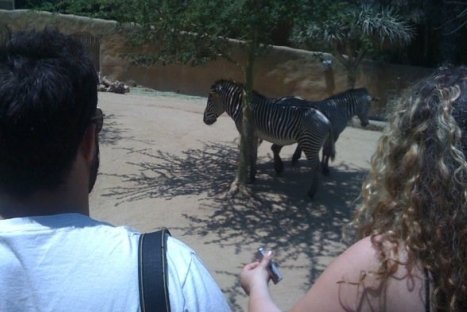
(Running continuously unless otherwise noted):
Cheyenne's Men Don't Get Killed Travis Diehl
Projection. A shaky video eye traverses the husk of myth, strewn with bodies perfectly preserved in their cinematic persistence.
Lucky Luke Rasmus Røhling
A Franco-Belgian comic series, set in the American Old West. One of the most popular and best-selling comic book series in continental Europe, but only a minority of the series' adventures have been published in the US. Three of these comics will be given to the ranch library and are on view here.
Seeing the Converse Home Movies Chiara Giovando
The home movies of the Converse Family (original builders of the Ranch, circa 1908) were found recently at a yard sale. Little is known about the imagery, who is pictured exactly and when. What is known can be discerned from the site, the ranch, and clues in the landscape and clothing. This site work is an investigation into the transferring process that occurred after the original film rolls were found and how that seemingly unbiased technical process has left us with a specific narrative film.
Animals, Spectators, Hay Rena Kosnett
3 sound installations comprised of: the noises which would have been made by a selection of the exotic animals that roamed the property of Safari West (this property, now named Deep End Ranch) as it was in the years 1970-1984, then owned and operated by Peter Lang (son of filmmaker Otto Lang)/ human spectator sounds made when viewing enclosed wild animals/ an interview with Richard Haller of Santa Paula's Haller Hay company, whom delivered hay for Lang's animals and some of the animals themselves.
We Cross Sometimes Alison J Carr
During various periods of its history the ranch has been unoccupied and abandoned leading to rumors that it was haunted. Carr invited 3 psychics to the ranch and recorded their conversation paying attention to one of the psychics 'automatic writing'. A lot of what they revealed can be substantiated and the new stories also seem very plausible.
The Golden Lemons of Baron Apthous Von Canker Lakshmi Luthra and Brica Wilcox
Between 1849 and 1852 the Deep End ranch was the site of production of Baron Apthous Von Canker's golden lemons. During this time the golden lemon nearly replaced federally minted coins as the money of California. Come pick-up a map for our self-guided walking tour and learn about this fascinating but little known episode in our country's history!
Our Homeland Security, a work in progress Karolina Karlic
Encounter documents of the American unreason... As immigration and the auto industry have climaxed in popular media discussion, this installation raises and grounds the current issues at hand and brings them together through the site of Santa Paula.
Pony, Farming, Immigration and Labor Sage Paisner
A story that deals with the issues of how this and other countries are built on the labor of immigrants and an old man’s story of how he traded his red bike for a one-eyed pony. Video.
Housing Development Grafting Project Zach Kleyn
Site-specific sculpture examining the relationship between modern housing developments and the practice of grafting organic plant life.
En Plein Air Erich Bollman
A survey of the ranch and surrounding geography through the local tradition of plein air painting, which will be displayed on site, and also used in virtual space (online in Google Maps & Panoramio) as a recording of the space.
Kitchen Window (Eldhúsgluggi) Bjarki Bragason
In this video installation a dichotomy of two failed farms, one in Santa Paula (CA) and the other in Eastern Iceland is put up. Both farms stem from epic ideas of life in the country and subsequently fail, only to be resurrected into artist residency projects.
Artists Work Greg Wells
Documenting an experiment where artists work alongside Gerardo Patiño (ranch foreman) and me during a regular day as a ranch labourers.
Timed events:
3:00 pm Seminar – with Sage Paisner
Strategies of Native gardening and understanding of the land as well as a discussion about gardening as art and activism, establishing a co-op for the summer to help feed our communities. Topics also include the mental and physical healing that gardening and eating your own food can have on a community. Held on the site of Paisner’s Hopi Zen influenced community garden. 1 hour.
4:00 pm California Hates You! Rachel McRae
The drowsy, golden surface of the Californian landscape stretches taut over an unstable substructure, pleasantly masking its "distinctly catastrophic" nature. (Clarence King, first head of the United States Geographic Survey) Here is the illusion of solid ground. P.S. California hates you! An informal walk along the surface of a scar that runs through the Ventura Basin. We will travel a tiny fragment of this 70 mile fracture, the Oak Ridge Fault, considered to be a possible cause of the Northridge quake. Bring sunglasses and a hat.
45 minutes
5:00 pm We Bought The Farm David Bunn
David Bunn and Ellen Birrell (farmers!) lead a tour of the farm. With 33 acres under cultivation, they’re growing lemons, tangerines and avocados. They have just grafted 100 orange, grapefruit and avocado trees and are preparing to plant 1000 more tangerine trees before July 1. 1 hour
6:30 pm Harvest feast
A lemon inspired dinner. Bring a dish to contribute if you wish (lemons not required).
8:30 pm Collage-cowboy sings forlorn song to a New Frontier
Performance by Orlando Tirado Amador with Projection Loop by Rhys Ernst.
10 minutes
9:00 pm DJ Cowboy Gerardo Patiño
From a pickup, resident cowboy and ranch foreman Gerardo Patiño will mix from his special collection of Mexican and Anglo Country Western music





























































